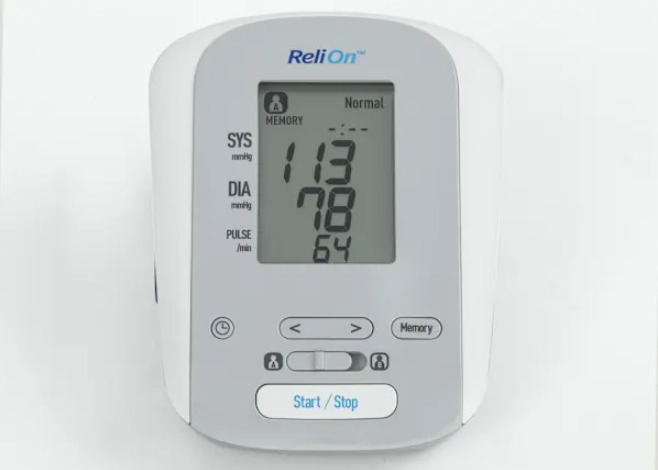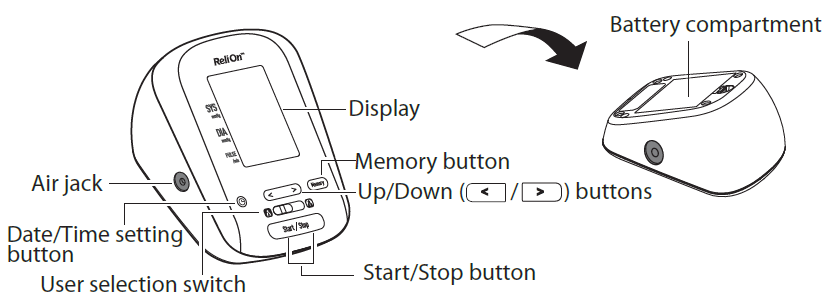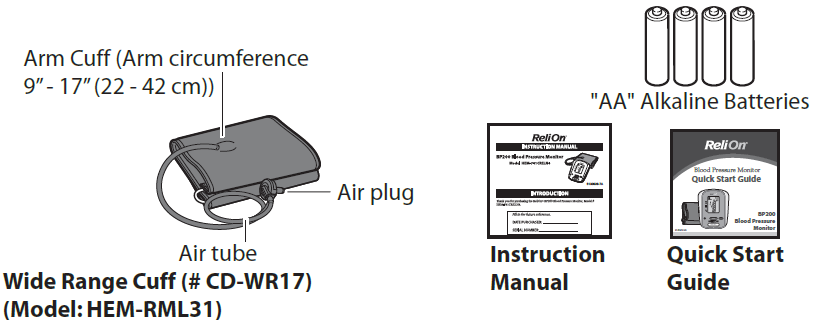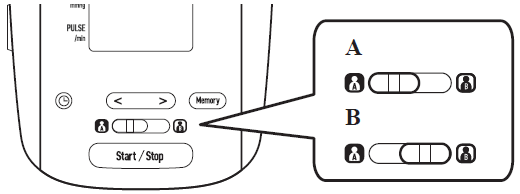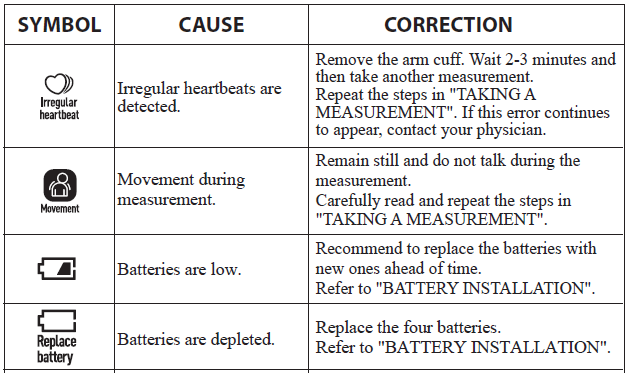
Relion BP200 Upper Arm Blood Pressure Monitor
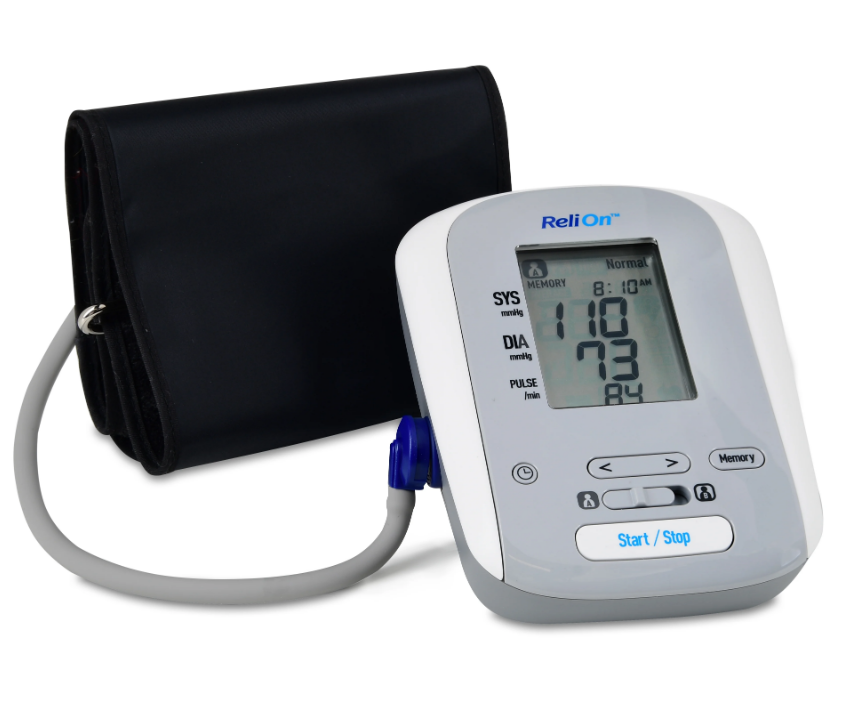
GENERAL USAGE
- DO NOT adjust medication based on measurement values from this blood pressure monitor. Take medication as prescribed by your physician. Only a physician is qualified to diagnose and treat High Blood Pressure.
- The monitor is not intended to be a diagnostic device.
- Consult your physician before using the device for any of the following conditions: common arrhythmias such as atrial or ventricular premature beats or atrial fibrillation, arterial sclerosis, poor perfusion, diabetes, age, pregnancy, pre-eclampsia, or renal diseases. Note that PATIENT motion, trembling, and shivering may affect the measurement value.
- Do not use the device on the injured arm or the arm under medical treatment.
- Do not apply the arm cuff on the arm while on an intravenous drip or blood transfusion.
- Consult your physician before using the device on the arm with an arterio-venous (A-V) shunt.
- Do not use the device with other medical electrical (ME) equipment simultaneously.
- Do not use the device in the area of HF surgical equipment, MRI, or CT scanner, or in an oxygen-rich environment.
- The air tube may cause accidental strangulation in infants.
- Contains small parts that may cause a choking hazard if swallowed by infants and small children.
SAFETY INFORMATION
- Always consult your physician. Self-diagnosis of measurement values and self-treatment are dangerous.
- Consult your physician before using the device for any of the following conditions:
- If you have had a mastectomy.
- People with severe blood flow problems or blood disorders as cuff inflation, can experience bruising.
- Do not take measurements more than necessary. It may cause bruising due to blood flow interference.
- Remove the arm cuff if it does not start deflating during the measurement.
- Do not use this device on infants or persons who cannot express their intentions.
- Do not use the device for any purpose other than measuring blood pressure.
- Use only the approved arm cuff for this device. Use of other arm cuffs may result in incorrect measurement values.
- Do not use a mobile phone or other devices that emit electromagnetic fields near the device. This may result in incorrect operation of the device.
- Use only Omron authorized parts and accessories. Parts and accessories not approved for use with the device may damage the unit.
- Do not disassemble the monitor or arm cuff. This may cause an inaccurate reading.
- Do not use in a location with moisture or a location where water may splash on the device. This may damage the device.
- Do not use the device in a moving vehicle. For example, the car or airplane.
- Read “If your systolic pressure is more than 210 mmHg” in the “TAKING A MEASUREMENT” section in this manual if your systolic pressure is known to be more than 210 mmHg. Inflating to a higher pressure than necessary may result in bruising where the cuff is applied.
BATTERY USAGE
- Do not insert the batteries with their polarities incorrectly aligned.
- Use only 4 “AA” alkaline or manganese batteries with this device. Do not use other types of batteries. Do not use new and used batteries together.
- Remove the batteries if the device will not be used for three months or more.
- If battery fluid should get in your eyes, immediately rinse with plenty of clean water. Contact a physician immediately.
GENERAL PRECAUTIONS
- Do not forcibly crease the arm cuff or the air tube excessively.
- Do not press the air tube while taking a measurement.
- To unplug the air plug, pull on the air plug at the connection with the monitor, not the tube itself.
- Do not drop the monitor or subject device to strong shocks or vibrations.
- Do not inflate the arm cuff when it is not wrapped around your arm.
- Do not use the device outside the specified environment. It may cause an inaccurate reading.
- Dispose of the device, components, and optional accessories according to applicable local regulations. Unlawful disposal may cause environmental pollution.
BEFORE TAKING A MEASUREMENT
To ensure a reliable reading, follow these recommendations:
- Avoid eating, drinking alcohol, smoking, exercising, and bathing for 30 minutes before taking a measurement. Rest for at least 5 minutes before taking the measurement.
- Stress raises blood pressure. Avoid taking measurements during stressful times.
- Measurements should be taken in a quiet place.
- Remove tight-fitting clothing from your arms.
- Sit on a chair with your feet flat on the floor. Rest your arm on the table so that the cuff is at the same level as your heart.
- Remain still and do not talk during the measurement.
- Keep a record of your blood pressure and pulse readings for your physician. A single measurement does not provide an accurate indication of your true blood pressure. You need to take and record several readings over a period of time. Try to measure your blood pressure at the same time each day for consistency.
KNOW YOUR UNIT
Main Unit:
Components:
UNIT DISPLAY
DISPLAY SYMBOLS
IRREGULAR HEARTBEAT SYMBOL
When the monitor detects an irregular rhythm two or more times during the measurement, the Irregular Heartbeat Symbol will appear on the display with the measurement values.
An irregular heartbeat rhythm is defined as a rhythm that varies by 25% less or 25% more than the average rhythm detected while the monitor is measuring the systolic and diastolic blood pressure.
If the irregular heartbeat symbol displays with your measurement values, we recommend you consult your physician. Follow the directions of your doctor.
MOVEMENT ERROR SYMBOL
The Movement Error Symbol is displayed if you move your body during the measurement. Please remove the arm cuff, and wait 2-3 minutes. Re-apply the arm cuff and take another measurement.
AVERAGE READING SYMBOL
The Average Reading Symbol is displayed when you press and hold the MEMORY button for more than 3 seconds.
The average reading based on the last 3 measurement values taken within 10 minutes appears on the display screen.
HEARTBEAT SYMBOL
The Heartbeat symbol flashes on the display at every heartbeat during the measurement.
BLOOD PRESSURE LEVEL INDICATOR
If your Systolic Blood Pressure is 135 mmHg or above and/or the Diastolic Blood Pressure is 85 mmHg or above, the High Blood pressure level indicator (HIGH) will display when the measurement value is displayed.
If the measurements are within the standard range, the Normal Blood pressure level indicator (NORMAL) will display.
BATTERY INSTALLATION
- Press the hook on the top of the battery cover and lift the cover off in the direction of the arrow.
- Install 4 “AA” size batteries so the + (positive) and – (negative) polarities match the polarities of the battery compartment as indicated.
- Replace the battery cover.
NOTES:
- When the depleted battery symbol (REPLACE BATTERY) appears on the display, turn the monitor off, then replace all batteries at the same time. Long-life alkaline batteries are recommended.
- Turn the unit off before replacing the batteries. If the batteries are removed while the unit is still on, the date and time will be reset to that of the previous use. The measurement values are not deleted.
- When the batteries are replaced, you may need to reset the date and time. If “-:–” appears on the display, refer to “Setting the Date and Time”.
- The batteries included with the device may have a shorter life.
SETTING THE DATE AND TIME
Set the monitor to the correct date and time before taking a measurement for the first time or after replacing the batteries.
- Press the DATE/TIME SETTING button to show the year.
- Push the UP or DOWN button to change the year. The year can be set between 2015 and 2045. When the display reaches 2045, it will return to 2015.
- Push the DATE/TIME SETTING button to confirm the year, and then the month flashes. Repeat the same steps to change the month, day, hour, and minute. NOTE: Press and hold the UP or DOWN button to increase the date and time values faster.

- Press the Start/Stop button to turn the monitor off.
APPLYING THE ARM CUFF
APPLYING THE CUFF ON THE LEFT ARM
- Make sure the air plug is securely inserted in the main unit.
- Remove tight-fitting clothing from your upper arm.
- Apply the cuff to your left upper arm so the air tube is centered on the inside of your arm and aligned with your middle finger. The air tube runs down the inside of your arm. The bottom of the cuff should be approximately 1/2 inch (1 – 2 cm) above your elbow.
- Wrap the cuff firmly in place around your arm using the cloth fastening in the direction of the arrow.
APPLYING THE CUFF ON THE RIGHT ARM
When taking a measurement using the right arm, use this instruction for Step 3.
Apply the cuff to your right upper arm so the air tube runs along the inside of your arm. The bottom of the cuff should be approximately 1/2 inch (1 – 2 cm) above your elbow.
NOTES: Be careful not to rest your arm on the air tube. This will restrict the flow of air to the cuff.
When you take a measurement on the right arm, the air tube will be at the side of your elbow. Be careful not to rest your arm on the air tube.
TAKING A MEASUREMENT
The monitor is designed to store the blood pressure and the pulse rate in the memory for two people (USER A or USER B) every time a measurement is completed.
- Sit on a chair with your feet flat on the floor. Place your arm on a table so the cuff is level with your heart. Remain still and do not talk during measurement.
- Select your user ID (A or B).

- Press the Start/Stop button. All symbols appear on the display. The cuff starts to inflate automatically. As the cuff inflates, the monitor automatically determines your ideal inflation level. Remain still and do not move your arm until the entire measurement process is completed.
If your systolic pressure is more than 210 mmHg
After the arm cuff starts to inflate, press and hold the Start/Stop button until the monitor inflates 30 to 40 mmHg higher than your expected systolic pressure.
NOTE: The monitor will not inflate above 299 mmHg.
Inflating to a higher pressure than necessary may result in bruising where the arm cuff is applied.
NOTE: To stop the inflation or measurement, push the Start/Stop button. The monitor will stop inflating, start deflating, and turn off.
- Inflation stops automatically, and the measurement is started. As the cuff deflates, decreasing numbers appear on the display, and the Heartbeat Symbol flashes.
- When the measurement is complete, the arm cuff completely deflates. Your blood pressure and pulse rate are displayed.
- Remove the arm cuff.
- Press the Start/Stop button to turn the monitor off.
NOTES: The monitor will automatically turn off after 2 minutes. Wait 2-3 minutes before taking another measurement. Waiting between measurements allows the arteries to return to the condition prior to taking a measurement. You may need to increase the wait time depending on your individual physiological characteristics.
USING THE MEMORY FUNCTION
The monitor automatically stores the results up to 60 sets for each user (A and B). It can also calculate an average value based on the last 3 measurement values taken within 10 minutes.
TO VIEW THE MEASUREMENT VALUES STORED IN MEMORY
- Select your USER ID (A or B).
- Press the MEMORY button to display the set of measurement values. The Memory number appears for a second before the pulse rate is displayed. The most recent reading is numbered “1”.
- Press the UP or DOWN button to view the values stored in the memory.
- UP: To view the older values
- DOWN: To view the more recent values
NOTES: If the memory is full, the monitor will delete the oldest value.
The date and time are alternately displayed with the measurement values.
When viewing the measurement value taken without setting the date and time, “-:–” is displayed instead of the date and time.
If there are no measurement values stored in the memory, the screen to the right is displayed.
- Press the Start/Stop button to turn the monitor off.
TO VIEW THE AVERAGE READING
- Select your USER ID (A or B).
- Press and hold the MEMORY button for more than 3 seconds.
NOTES: If the previous measurement was taken without setting the date and time, the average reading is not calculated.
If two sets of measurement values are stored in the memory for the 10 minute period, the average is based on the two sets of measurement values. If only one set of measurement values is stored, this is displayed as the average.
TO DELETE ALL VALUES STORED IN THE MEMORY
The values stored in the memory are deleted by the USER ID.
You cannot partially delete values stored in memory. All values for the user you select will be deleted.
- Select your USER ID (A or B).
- Press the MEMORY button to turn the monitor on.
- When the memory symbol (MEMORY) appears, while pressing and holding the MEMORY button, press the Start/Stop button for 3 seconds to delete all values in the memory.
- Press the Start/Stop button to turn the monitor off.
NOTE: The monitor will automatically turn off after 2 minutes.
CARE AND MAINTENANCE
To keep your blood pressure monitor in the best condition and protect the unit from damage, follow the directions listed below:
- Do not forcefully bend the arm cuff or air tube. Do not fold tightly.
- Clean the monitor with a soft, dry cloth. Do not use any abrasive or volatile cleaners. Do not attempt to clean the cuff.
CAUTION
- Do not submerge the device or any of its components in water.
- Do not subject the monitor to extreme hot or cold temperatures, humidity, or direct sunlight.
- Store the device and the components in a clean, safe location.
- Do not subject the monitor to strong shocks, such as dropping the unit on the floor.
- Remove the batteries if the unit will not be used for three months or longer. Always replace all the batteries with new ones at the same time.
- Use the unit in a manner consistent with the instructions provided in this manual.
- Use only authorized parts and accessories. Parts and accessories not approved for use with the device may damage the unit.
- Changes or modifications not approved by the manufacturer will void the user warranty. Do not disassemble or attempt to repair the unit or components.
ERROR INDICATORS
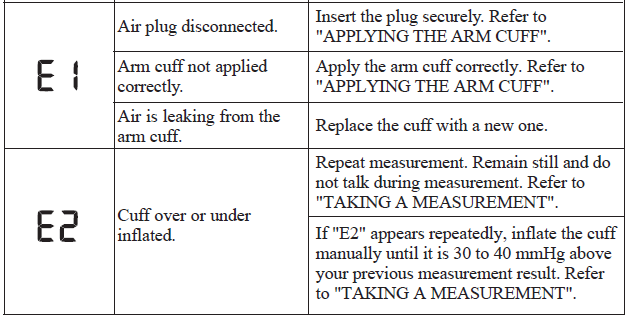
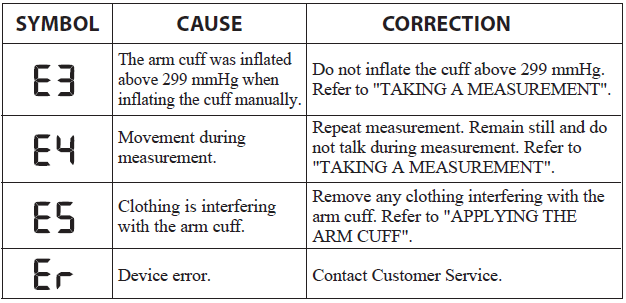
TROUBLESHOOTING TIPS
No power. No display appears on the unit.
Replace all four batteries with new ones.
Check the battery installation for proper placement of the battery polarities.
Measurement values appear too high or too low.
Blood pressure varies constantly. Many factors, including stress, time of day, and how you wrap the cuff, may affect your blood pressure. Review the sections “BEFORE TAKING A MEASUREMENT” and “TAKING A MEASUREMENT”.
FOR CUSTOMER SERVICE
Call toll-free: 1-855-776-0662
For more Manuals by Relion, visit ManualsLibraryy
Relion BP200 Upper Arm Blood Pressure Monitor-FAQs
How does an upper arm blood pressure monitor work?
The cuff is placed around your bare upper arm and inflated to temporarily stop blood flow. As air is slowly released, the monitor detects when blood starts flowing again, measuring systolic (top number) and diastolic (bottom number) pressure.
How do I properly use the ReliOn BP200 monitor?
Sit comfortably with feet flat on the floor.
Place the cuff 1 inch above your elbow on bare skin.
Ensure the tube runs down the center of your arm.
Stay still and avoid talking during measurement.
Can I calibrate the ReliOn BP200 monitor?
No, the ReliOn BP200 cannot be manually calibrated. To verify accuracy, compare readings with a validated monitor or have it checked by a healthcare provider.
Which arm should I use for measurement?
Measure in both arms initially to check for differences.
Use the arm with the higher reading for future checks (usually the right arm).
What are common errors in blood pressure readings?
Wrong cuff size.
Moving/talking during measurement.
Cuff over clothing.
Arm unsupported or not at heart level.
When is the best time to check blood pressure?
Morning: Before eating or taking medication.
Evening: Before bedtime.
Take 2–3 readings, 1 minute apart, and average them.
What does “Movement Error” mean?
This appears if you move during measurement. Remove the cuff, wait 2–3 minutes, and retake.
When is the best time to check blood pressure?
Morning: Before eating or taking medication.
Evening: Before bedtime.
Take 2–3 readings, 1 minute apart, and average them.
What does “Movement Error” mean?
This appears if you move during measurement. Remove the cuff, wait 2–3 minutes, and retake.
How do I know if my monitor is accurate?
Bring it to a doctor’s office and compare readings with their device. If results differ significantly, replace the monitor.
Why is my first reading always higher?
“White coat syndrome” or stress can temporarily elevate BP. Relax for 5 minutes before measuring.

